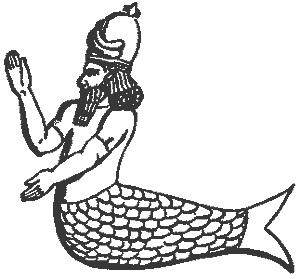|

|
Dagon was a major northwest Semitic god, reportedly of fish and/or fishing. He was
worshipped by the early Amorites and by the inhabitants of the cities of Ebla and Ugarit (which was an ancient city near the Mediterranean
containing a large variety of ancient writings and pagan shrines). He was also a
major member, or perhaps head, of the pantheon of the Biblical Philistines.The god Dagon first appears in extant records about 2500 BC in the Mari texts and in personal Amorite names in which the gods Ilu (Ēl), Dagan, and Adad are especially common.
At Ebla (Tell Mardikh), from at least 2300 BC, Dagan was the head of the city
pantheon comprising some 200
deities and bore the titles BE-DINGIR-DINGIR, "Lord of the gods" and Bekalam, "Lord
of the land". His consort was known only as Belatu, "Lady". Both were worshipped
in a large temple complex called E-Mul, "House of the Star". One entire quarter
of Ebla and one of its gates were named after Dagan. Dagan is called ti-lu
ma-tim, "dew of the land" and Be-ka-na-na, possibly "Lord of Canaan". He was called lord of many cities:
of Tuttul, Irim, Ma-Ne, Zarad, Uguash, Siwad, and Sipishu. In Ugarit around 1300 BC, Dagon had a
large temple and was listed third in the pantheon following a father-god and Ēl,
and preceding Baīl Ṣapān
(that is the god Haddu or Hadad/Adad). Joseph Fontenrose
first demonstrated that, whatever their deep origins, at Ugarit Dagon was
identified with El, explaining why
Dagan, who had an important temple at Ugarit is so neglected in the Ras Shamra
mythological texts, where Dagon is mentioned solely in passing as the father of
the god Hadad, but Anat, El's daughter, is Baal's sister, and why no temple
of El has appeared at Ugarit.
There are differences between the Ugaritic pantheon and that of Phoenicia
centuries later: according to the third-hand Greek and Christian reports of
Sanchuniathon, the Phoenician mythographer would have Dagon the brother of Ēl/Cronus and like him son of Sky/Uranus and
Earth, but not truly Hadad's father. Hadad was begotten by
"Sky" on a concubine before Sky was castrated by his son Ēl, whereupon the
pregnant concubine was given to Dagon. Accordingly, Dagon in this version is
Hadad's half-brother and stepfather. The Byzantine Etymologicon
Magnum says that Dagon was Cronus in Phoenicia.
Otherwise, with the disappearance of Phoenician literary texts, Dagon has
practically no surviving mythology.
Dagan is mentioned occasionally in early Sumerian texts but becomes prominent only in
later Akkadian inscriptions as a powerful and warlike protector, sometimes
equated with Enlil. Dagan's wife was in some sources the goddess Shala (also named as wife of Adad and sometimes
identified with Ninlil). In other texts, his wife is Ishara. In the preface to his famous law code, King Hammurabi calls himself "the subduer
of the settlements along the Euphrates with the help of Dagan, his creator". An
inscription about an expedition of Naram-Sin to the Cedar Mountain relates
(ANET, p. 268): "Naram-Sin slew Arman and Ibla with the 'weapon' of the
god Dagan who aggrandizes his kingdom." The stele of Ashurnasirpal II (ANET, p. 558) refers
to Ashurnasirpal as the favorite of Anu and of Dagan. In an Assyrian poem, Dagan
appears beside Nergal and Misharu as a
judge of the dead. A late Babylonian text makes him the underworld prison warder of the seven children of
the god Emmesharra.
The Phoenician inscription on the sarcophagus of King Eshmunʿazar of Sidon (5th century BC) relates (ANET,
p. 662): "Furthermore, the Lord of Kings gave us Dor and Joppa, the mighty lands of
Dagon, which are in the Plain of Sharon, in accordance with the important deeds
which I did." In the Tanakh, Dagon is particularly
the god of the Philistines with temples at Beth-dagon in the tribe of Asher (Joshua 19.27), in Gaza (Judges 16.23, which tells soon after how the
temple is destroyed by Samson as his
last act). Another temple, in Ashdod was
mentioned in 1
Samuel 5.2–7 and again as late as 1 Maccabees 10.83;11.4. King Saul's head was displayed in a temple of Dagon in 1 Chronicles 10:8-10. There was also a
second place known as Beth-Dagon in Judah (Joshua 15.41). Josephus (Antiquities 12.8.1; War 1.2.3)
mentions a place named Dagon above Jericho. Jerome
mentions Caferdago between Diospolis and Jamnia. There is also a modern Beit
Dejan south-east of Nablus. Some of
these toponyms may have to do with grain rather than the god.
The account in 1 Samuel 5.2–7 relates how the ark of Yahweh was captured by the Philistines and taken to
Dagon's temple in Ashdod. The following morning they found the image of Dagon
lying prostrate before the ark. They set the image upright, but again on the
morning of the following day they found it prostrate before the ark, but this
time with head and hands severed, lying on the miptān translated as
"threshold" or "podium". The account continues with the puzzling words raq
dāgôn nišʾar ʿālāyw, which means literally "only Dagon was left to him."
(The Septuagint, Peshitta, and Targums render "Dagon" here as "trunk of Dagon" or "body
of Dagon", presumably referring to the lower part of his image.) Thereafter we
are told that neither the priests or anyone ever steps on the miptān of
Dagon in Ashdod "unto this day". This story is depicted on the frescoes of the
Dura-Europos synagogue as the opposite
to a depiction of the High Priest Aaron
and the Temple of Solomon.
|
 Copyright(c) 2007
- 2020. All rights reserved. Copyright(c) 2007
- 2020. All rights reserved.
|

![]() Copyright(c) 2007
- 2020. All rights reserved.
Copyright(c) 2007
- 2020. All rights reserved.